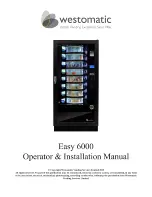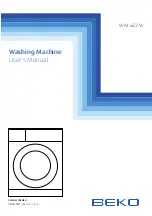
– 17 –
CAUTION:
Any changes or modifications not expressly approved by the party responsible
for compliance could void the user’s authority to operate this device.
Note:
This equipment has been tested and found to comply with the limits for a Class
B digital device, pursuant to Part 15 of the FCC Rules. These limits are
designed to provide reasonable protection against harmful interference in a
residential installation. This equipment generates, uses, and can radiate radio
frequency energy and, if not installed and used in accordance with the
instructions, may cause harmful interference to radio communications. However,
there is no guarantee that interference will not occur in a particular installation. If
this equipment does cause harmful interference to radio or television reception,
which can be determined by turning the equipment off and on, the user is
encouraged to try to correct the interference by one or more of the following
measures:
—Reorient or relocate the receiving antenna.
—Increase the separation between the equipment and receiver.
—Connect the equipment into an outlet on a circuit different from that to which
the receiver is connected.
—Consult the dealer or an experienced radio/TV technician for help.
Some cordless telephones operate at frequencies that may cause interference
to nearby TVs and VCRs. To minimize or prevent such interference, the base of
the cordless telephone should not be placed near or on top of a TV or VCR. If
interference is experienced, move the cordless telephone further away from the
TV or VCR. This will often reduce or eliminate interference.
≥
Environment—do not place the unit in a room where the temperature is less
than 5
o
C (41
o
F) or greater than 40
o
C (104
o
F). Allow 10 cm (4
q
) clearance
around the unit for proper ventilation. Avoid excessive smoke, dust,
mechanical vibration, shock, or direct sunlight.
≥
Medical—consult the manufacturer of any personal medical devices, such as
pacemakers, to determine if they are adequately shielded from external RF
(radio frequency) energy. (The unit operates in the frequency range of
902MHz to 928MHz and the power output level can range from 0.001 watts to
0.1 watts.) Do not use the unit in health care facilities if any regulations posted
in the area instruct you not to do so. Hospitals or health care facilities may be
using equipment that could be sensitive to external RF (radio frequency)
energy.
≥
Routine care—wipe the unit with a soft cloth. Do not use benzine, thinner, or
any abrasive powder. When you leave the unit unused for long period of time,
unplug the AC adaptor from the outlet.
≥
If there is any trouble—disconnect the unit from the telephone line and
connect a known working phone. If the known working phone operates
properly, have your unit repaired by one of the authorized Panasonic Factory
Service Centers. If the known working phone does not operate properly,
consult your telephone company.



































